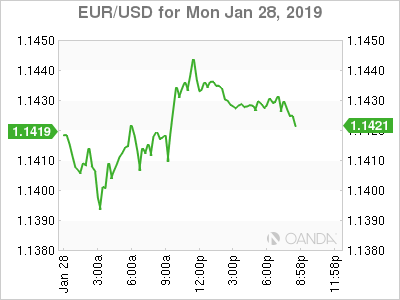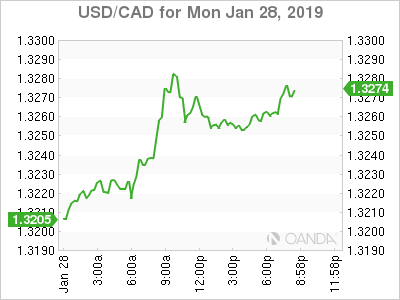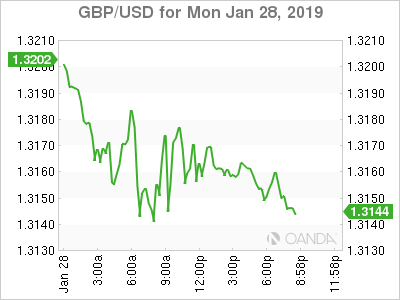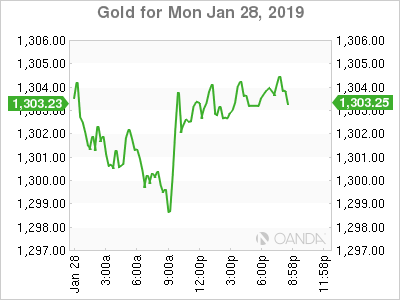EUR – Euro Rises on Soft Dollar
CAD – Loonie Lower on Soft China Data
GBP – Brexit Jitters Hit Pound Ahead of Vote
GOLD – Gold Rises awaiting Cautious Fed
OIL – Lower Global Growth and Higher Rig Counts Pressure Crude
The US dollar is mixed against mayor pairs on Monday. The safe havens are trending higher with the yen and Swiss franc gaining, joining the club is the euro as investors look to reduce their US dollar exposures as US political uncertainty rises.
The U.S. Federal Reserve is not expected to modify its monetary policy at the end of the 2-day FOMC meeting, but the press conference with Chair Powell will be tracked closely for any insights after several members have openly discussed pausing the path of rising interest rate hikes.
The Fed signalled on Friday that it could slow down the balance sheet reduction program put in place to keep tightening monetary policy adding to the factors putting pressure on the US dollar.
The currency has been sold after President Trump reached a deal to reopen the Federal government. Washington will continue to operate amidst political uncertainty with the discussed agreement only valid until February 15 when a new shutdown could occur if Democrats and the GOP don’t reach a deal on the border wall.
EUR – Euro Rises on Soft Dollar Despite Dovish ECB
The EUR/USD rose 0.25 percent on Monday. The single currency is trading at 1.1435 as investors sold the dollar searching for higher yields.
Political uncertainty in Washington kept investors from flocking to the US dollar ahead of the weekend and the dovish expectations on the FOMC meeting are not giving any support to the greenback.
The CME FedWatch tool shows the market is forecasting a 99.5 percent probability that the Fed funds rate remains unchanged at 225–250 basis points range.
The currency rose last year as geopolitical factors and the support of the central bank’s efforts to normalize interest rates.
The Fed had tightened monetary policy by raising rates, but also by unwinding the massive balance sheet it had accumulated as part of its quantitative easing program. Friday’s report in the WSJ about a possible end or long-term pause to the balance sheet reduction was a positive for the stock market, but a negative to the US dollar.
The dollar is not attracting investors as a safe haven. US-China trade concerns remain, but they are moving to the background as negotiators begin. The uncertainty on the US shutdown lessened with a short-term agreement and the Fed is to take center stage with dovish expectations from the market.
The US U.S. non-farm payrolls (NFP) report is expected to keep showing that American employment is solid.
CAD – Loonie Lower on Soft China Data
The Canadian dollar fell 0.32 percent on Monday. The USD/CAD is trading at 1.3254 as lower oil prices hit the loonie. The commodity currency also got hit by lower industrial data out of China.
The US-China trade war has started hitting revenue targets around the globe. Growth forecasts have been cut as teams from the two nations meet in Washington with little chance of a successful agreement.
Canadian economic data this week will provide little support for the currency as this week’s calendar only features the monthly GDP data and raw materials price index, due on Thursday.
The US dollar sentiment could worsen as political events take the spotlight, but for now the market is showing a lack of confidence in the Canadian economy as headwinds increase.
GBP – Brexit Jitters Hit Pound Ahead of Vote
The pound lost 0.30 percent on Monday. The GBP/USD is trading at 1.3160 as the anticipated second Brexit vote is in the horizon.
Investors had low expectations on the first vote, which was lost in spectacular fashion but since then the efforts to minimize the no-deal scenario had appreciated the pound.
The currency is giving some of those gains back as investors take profits and confidence begins to wane on what the actual plan B will look like. A failure this time around will be a harder hit for the currency and put a no-deal exit back on the table.
The British parliament voted down the deal but is still divided on what it does support and what eventually might pass lawmakers in the UK, might not be the deal Europe agreed, which puts things back to square one, with a fast-approaching deadline. That is why the no-deal option is back in play.
GOLD – Gold Rises awaiting Cautious Fed
Gold rose 0.3 percent on Monday. The yellow metal is rising as the Fed is heavily anticipated to hit the pause button on monetary policy tightening.
The January Federal Open Market Committee (FOMC) meeting was intended to be a low-key event, after the rate hike in December of 2018. The equity market sell off and the political attacks on the central bank from the White House have put the Fed on the defensive. Chair Jerome Powell is all for transparency, and this year a press conference will follow every meeting.
Gold was caught in a familiar range last week, with limited details on global macro risk events. Friday’s report of the Fed holding on to more Treasuries than originally intended ahead of a FOMC meeting where no change to the Fed funds rate is expected and a dovish Powell put downward pressure on the dollar.
The yellow metal will continue to be an option for investors if volatility rises during the week on any development from Brexit, Venezuela and the US-China trade war.
US economic indicators schedule this week could also keep gold from rising next week. US employment and manufacturing data remain solid and could boost the greenback but given the US shutdown the indicators could miss forecast due to incomplete data.
OIL – Lower Global Growth and Higher Rig Counts Pressure Crude
Energy prices fell close to 3 percent on Monday. West Texas Intermediate dropped 3.41 percent and Brent 2.97 percent as lower demand impacted by falling global growth forecasts.
Rising supplies continue to put downward pressure on crude prices despite the efforts of the Organization of the Petroleum Exporting Countries (OPEC) and other major producers to limit production.
Rising US output and the possible European bypass of US sanctions on Iranian crude offset any disruptions caused by the political situation in Venezuela.
Oil supplies have remained untouched since the US backed an interim president over Nicolas Maduro. US refineries would scramble to find a replacement for their heavy grade imports causing a spike in short term demand if sanctions on either side of the dispute are put in place.
Soft industrial data in China and the United States put downward pressure on energy prices as demand is seen lower.
The OPEC agreement to limit output has stabilized prices, but energy is still sensitive to higher crude output from the United States and downgrades in global growth due to higher tariffs to international trade.



















